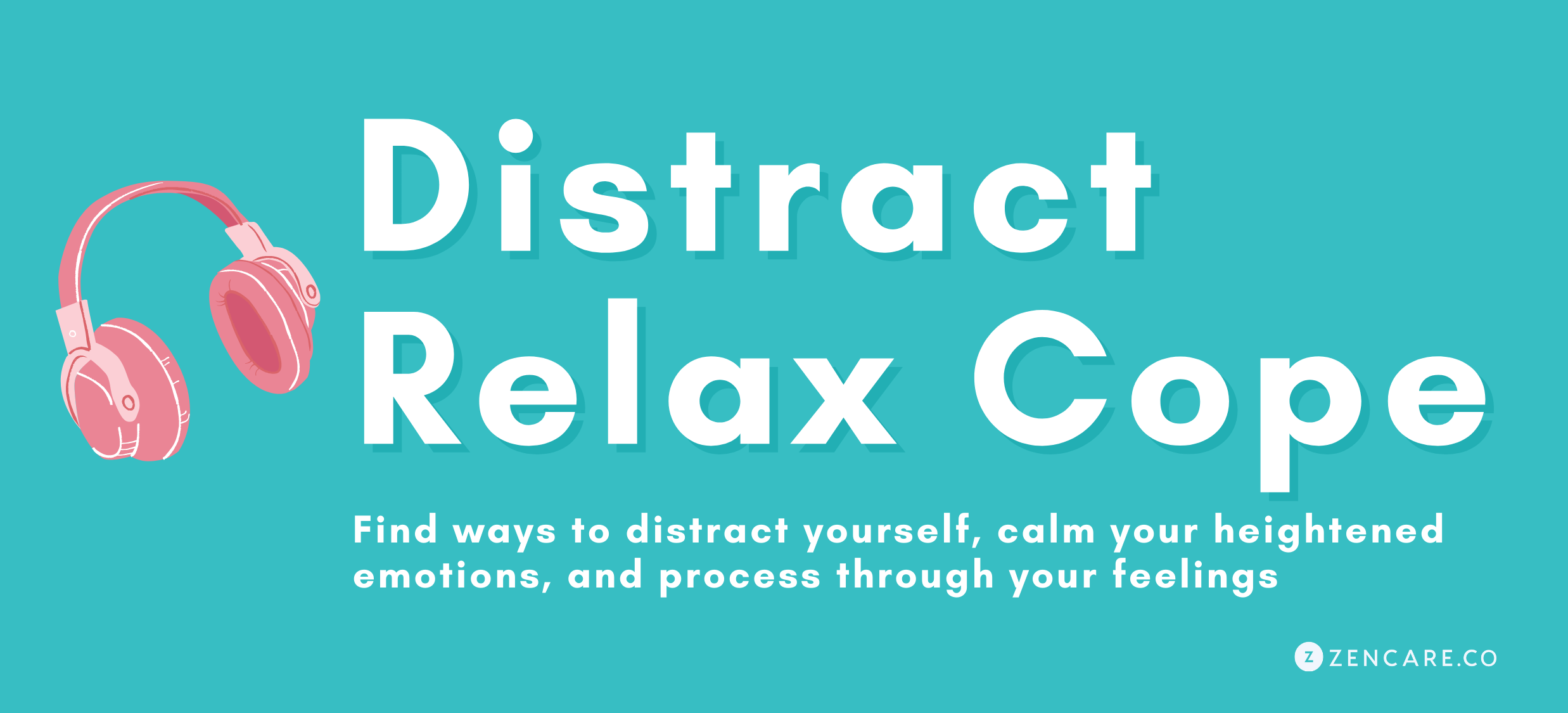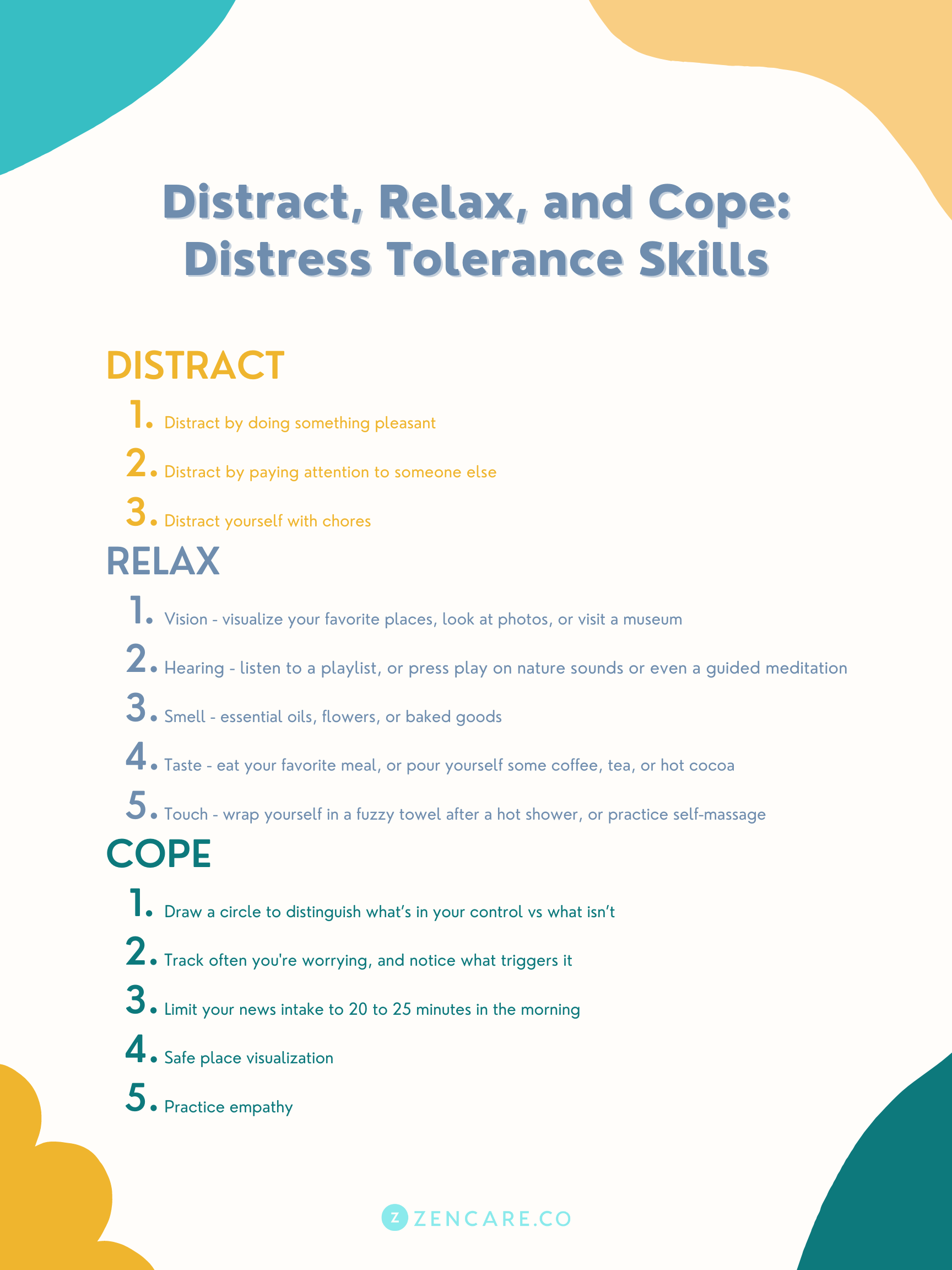When faced with a situation that is outside of your control, it's easy to get bogged down in overwhelming negative emotions. In times like these, it may be helpful to turn to distress tolerance skills, a set of strategies that help you regulate your emotional response to stressful situations.
One such strategy is Distract, Relax, and Cope, from Dialectical Behavioral Therapy (DBT). This technique guides your response to stress by first distracting from the overwhelming emotion, then soothing yourself through calming activities, and lastly, developing a plan to cope with the emotion more constructively. By stepping away from feelings of overwhelm, you can approach situations with a more level, grounded perspective.

1. Distract
The next time you realize you’ve become upset, stressed, panicked, or anxious, actively decide to think about something else by doing something distracting.
Distract by doing something pleasant
By turning your attention to something you enjoy, you can immerse yourself in the present moment and a different, more positive emotion!
Select an activity from this Big List of Pleasant Activities, or come up with your own list of distracting, pleasant activities.
Distract by paying attention to someone else
Thinking of others during this stressful time can serve as a gentle reminder that we’re all facing tough times together!
Turn your thoughts to others with one of these (quarantine-friendly) social distractions:
- Check in on how your neighbors are doing via the Nextdoor platform. You can also discuss vital topics like which grocery stores are honoring social distancing, which restaurants are offering delivery services, and other helpful, hyper-local need-to-knows.
- Sit by a window & people watch! Keep your social distance, but don’t forget to wave at the passersby.
- Volunteer virtually. You can reach out to any organizations that you admire to see if they need virtual support. Alternatively, get started with an organization that is already structured for online volunteers. Depending on your availability and ability, for example, opportunities can range from Be My Eyes (which connects blind and low-vision people with sighted volunteers) to serving as a digital volunteer for the Smithsonian Institute.
Distract yourself with chores
If the satisfaction of completing a task is something that brings you joy, now’s a good time to plug through any backburner items you haven’t had a chance to get through.
Consider distracting yourself with chores like these:
- Gather clothes to donate to your local thrift store at a future date.
- Redecorate a room that feels stagnant – or just move around a few items to give it a fresh look. Even bringing in a plant from another room can instantly spruce up a space that feels stale.
- If you have the space at home, consider taking advantage of the spring weather to try your thumb at gardening or starting your own compost pile. If you have a backyard or patio, you’ll get to continually spend time outside without having to leave your home.
- Do batch meal prep and store leftovers in your freezer. If your local grocery store is out of frozen fruits or vegetables, for example, consider buying the fresh ones instead to chop and freeze for a future date. For an extra-enriching distraction, make the time you spend in the kitchen a moving meditation by focusing your full attention and senses on each step of the prep-work.
2. Relax
Once you've effectively distracted your mind, it's time to calm down, relaxing your mind and body through sensory stimulation. The following ideas utilize the five senses – consider them a launching point, and experiment to find what is best for you and your lifestyle:
Vision
- Virtually visit your favorite places or places you want to travel via Google street-view.
- Check out a museum in your city (or beyond!) via a virtual tour. With a simple click, you can visit the Musée D'Orsay in Paris, the National Museum of Modern and Contemporary Art in Seoul, and the RijksMuseum in Amsterdam.
- Watch the cherry blossoms bloom at the Brooklyn Botanic Garden.
- Look through photos of happy memories.
Hearing
- Queue an upbeat playlist to turn up when you’re feeling down. Spotify even has coronavirus themed playlist to brighten your spirits!
- Open your window and listen to the street noise! Reconnect to the outside world by listening to any chirps, music, or cars that are bringing auditory life to your neighborhood.
- Listen to a meditation, virtual nature sounds, or even calming white noise.
Smell
- Take a whiff of relaxing essential oils, or pour a few drops into an aroma diffuser in a room where you’re relaxing. Good scents to try for anti-stress include lavender, rose, and ylang ylang.
- Stop and smell the roses – or the jasmine, chamomile, or peppermint, all of which can help the body destress.
- If you find baking to be a relaxing activity, now’s a good time to whip up a recipe and enjoy the delicious aroma that arises from your oven.
Taste
- There’s definite comfort in preparing or enjoying your favorite meal. If you have the ingredients for it, now’s a good time to prepare a dish that brings you joy.
- Pour yourself a cup of tea, coffee, or hot cocoa, and enjoy the different tastes. Is it sweet, bitter, smoky? Treat it like a fine glass of wine by mapping out the flavor profile and fully immersing yourself in the experience of drinking it!
Touch
- Wrap yourself in a fluffy towel after a hot shower, or switch out your bed linen for your favorite sheets – then enjoy a lie-in in the morning.
- Practice self-massage. For most exercises, all you need is your hands! If you have a tennis ball handy, you can massage the balls of your feet or your lower back, if you’re positioned against a wall.
3. Cope
Once you’ve reached a calmer space, mentally and physically, you can try turning to the issue at hand – the “coping” part of the three-part process. Here are ideas for proactively and productively coping with stress:
- Draw a circle to distinguish what’s in your control vs what isn’t. Write the things that are in your control on the inside of the circle, and the things that are outside your control on the outside of the circle. Focus on what is in your control, then recognize and do your best to emotionally release what’s outside the circle.
- Track how many times you’re worrying. Tallying the amount of times that you’re worrying reminds you that more fretting isn’t necessarily going to help. If you prefer, you can even schedule “worry time” on your calendar (or set an ongoing alarm on your phone). This allows you a concentrated time to actively think about it, rather than worrying about it throughout the day.
- Limit your news intake to 20 to 25 minutes in the morning. It’s easy to get overwhelmed with by the national and global news cycle. Try limiting the amount of news that you read or watch to just under 30 minutes in the morning (and turn off phone alerts if those prove too distracting).
- Safe place visualization: Imagine a place where you feel safe, calm and peaceful. This might be somewhere you know (like a trusted friend’s home), or an imaginary place (like a beach house you want to someday own). Focus on the five senses: The colors, sounds, smells, and physical sensations that you would experience there. You can “linger” there until you feel more relaxed in your present, and “return” if you’re feeling stressed in the future!
- Practice empathy. Remember that everyone is under more stress these days – try to remain your most gracious self, and understanding of others who are in even more challenging situations.
It’s often challenging to remain calm when things feel uncertain. By focusing on self-care and comfort, as well as channeling your energy into what is in your control rather than exerting it onto what isn’t, you’ll set yourself up for relative comfort during this stressful time. And if you need extra support, consider connecting or reconnecting with a therapist for online sessions.
